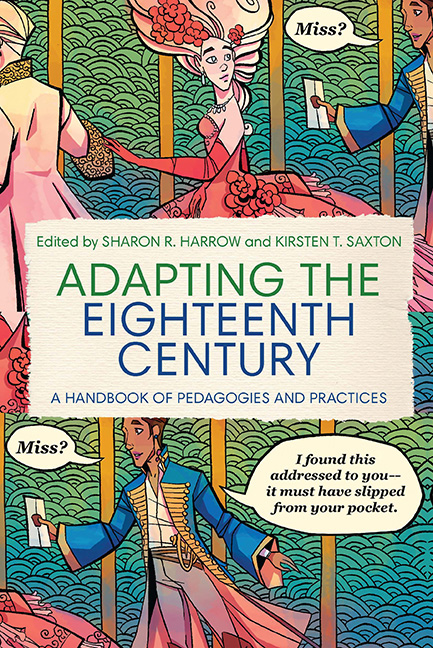Book contents
- Frontmatter
- Dedication
- Contents
- Acknowledgments
- Introduction
- 1 “Je suis Voltaire,” or, Appropriating the Philosophe in the Social Media Age
- 2 “Who Lives, Who Dies, Who Tells Your Story?”: The Uses of Hamilton in Special Collections Pedagogy and Public Engagement
- 3 Performing Frankenstein in the South: Sex, Race, and Science across the Disciplines
- 4 French Fairy Tales and Adaptations in the Twenty-First-Century Classroom
- 5 Select Trials at the Sessions-House in the Old-Bailey (1742) and Mark Ravenhill’s Mother Clap’s Molly House (2001)
- 6 Teaching with The Pilgrim’s Progress Video Game
- 7 Eliza Haywood’s “Bad Habits”: Teaching Adaptations of Fantomina: or, Love in a Maze and The Distress’d Orphan; or, Love in a Madhouse
- 8 Teaching Eighteenth-Century Literature through Eighteenth- Century Adaptations: Adaptive Structures
- 9 “A Private Had Been Flogged”: Adaptation and the “Invisible World” of Jane Austen
- 10 Fifty Shades of Pamela in the Undergraduate Classroom
- 11 Teaching the Austen-Monster-Mashup: Sense and Sensibility and Sea Monsters
- 12 Learning to Adapt: Teaching Pride and Prejudice and Its Adaptations in General Education Courses
- 13 Race and Romance: Adapting Free Women of Color in the Long Eighteenth Century
- 14 The Crusoeiana: Material Crusoe
- 15 Adaptation in Strange Places: Terrence Malick’s To the Wonder and the Narrative Effect and Form of Samuel Richardson’s Pamela
- 16 Adapting the Tombeaux des Princes: A Study in Media Variations
- 17 Experiential Pedagogy to Join the Thread of Conversation with Paul et Virginie
- 18 “Lookin’ for a Mind at Work”: Hamilton, Adaptation, and Enlightenment Ideals for the Core Curriculum
- Notes on the Contributors
- Index
4 - French Fairy Tales and Adaptations in the Twenty-First-Century Classroom
Published online by Cambridge University Press: 26 April 2020
- Frontmatter
- Dedication
- Contents
- Acknowledgments
- Introduction
- 1 “Je suis Voltaire,” or, Appropriating the Philosophe in the Social Media Age
- 2 “Who Lives, Who Dies, Who Tells Your Story?”: The Uses of Hamilton in Special Collections Pedagogy and Public Engagement
- 3 Performing Frankenstein in the South: Sex, Race, and Science across the Disciplines
- 4 French Fairy Tales and Adaptations in the Twenty-First-Century Classroom
- 5 Select Trials at the Sessions-House in the Old-Bailey (1742) and Mark Ravenhill’s Mother Clap’s Molly House (2001)
- 6 Teaching with The Pilgrim’s Progress Video Game
- 7 Eliza Haywood’s “Bad Habits”: Teaching Adaptations of Fantomina: or, Love in a Maze and The Distress’d Orphan; or, Love in a Madhouse
- 8 Teaching Eighteenth-Century Literature through Eighteenth- Century Adaptations: Adaptive Structures
- 9 “A Private Had Been Flogged”: Adaptation and the “Invisible World” of Jane Austen
- 10 Fifty Shades of Pamela in the Undergraduate Classroom
- 11 Teaching the Austen-Monster-Mashup: Sense and Sensibility and Sea Monsters
- 12 Learning to Adapt: Teaching Pride and Prejudice and Its Adaptations in General Education Courses
- 13 Race and Romance: Adapting Free Women of Color in the Long Eighteenth Century
- 14 The Crusoeiana: Material Crusoe
- 15 Adaptation in Strange Places: Terrence Malick’s To the Wonder and the Narrative Effect and Form of Samuel Richardson’s Pamela
- 16 Adapting the Tombeaux des Princes: A Study in Media Variations
- 17 Experiential Pedagogy to Join the Thread of Conversation with Paul et Virginie
- 18 “Lookin’ for a Mind at Work”: Hamilton, Adaptation, and Enlightenment Ideals for the Core Curriculum
- Notes on the Contributors
- Index
Summary
In 1696, Madame d’Aulnoy published her first collection of “contes de fees,” which introduced the term “fairy tales” into the salons of Louis XIV. In 2012, I introduced that same theme in a course entitled French Fairy Tales/Les Contes de fées français. This upper division undergraduate course explored French lan- guage and literature through the study of French fairy tales, their origins, and their interpretations over three centuries. Students read and interpreted pri- mary literary texts from Marie de France's 1180 title “Lais” to Marcel Aymé's 1920 title “Contes bleus,” then evaluated both their socio-political origins and their authorial perspectives. They examined period adaptations and, as the class progressed, also read and contrasted contemporary adaptations of those same tales as interpreted in alternative media formats. The syllabus noted that, during the course of the semester, students would have weekly reading assign- ments, write three 2-page papers (explications de texte) and one final paper of eight-to-ten pages, and would make four oral class presentations of ten-to-fif- teen minutes each. An important component of the final grade would be their participation in class discussion and activities.
Starting with a clear chronological and developmental progression in the early phase of the course allowed students to gain confidence in the material, which helped make it a success. In fact, the course was so popular with our students that it was added to the schedule again in 2015. That group took adaptation in a decidedly different direction, revealing the flexibility possible in such a course. My chapter explores the highlights of those experiences and the pedagogies that informed them, teaching Early Modern thought to undergraduates by emphasizing three learning objectives:
1. Literary acquisition: reading, understanding, and analysis of Early Modern fairy tales that included their origins, traditions, and structural components;
2. Cultural insight: the introduction of the salon through role-playing to embody a historical milieu where intellectuals—and particularly women—could gather for the exchange of scholarly ideas, literary criticism, and social support for each other;
3. Informed adaptation: final projects that included French-language representations of traditional tales, recreated into modern relevance through multimedia representations.
- Type
- Chapter
- Information
- Adapting the Eighteenth CenturyA Handbook of Pedagogies and Practices, pp. 71 - 84Publisher: Boydell & BrewerPrint publication year: 2020



